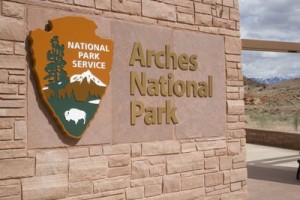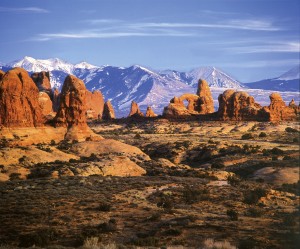I had no idea Moab, Utah was atomic. Dummy me, I just thought it was a famous place to enjoy the outdoors.
 This little town of 4,800 people in the Colorado plateau just south of the Colorado River is a mecca for outdoor enthusiasts. They flock there by the thousands to ride mountain bikes on the famous Slickrock trail, ride off-road in the annual Jeep Safari and visit two nearby National parks.
This little town of 4,800 people in the Colorado plateau just south of the Colorado River is a mecca for outdoor enthusiasts. They flock there by the thousands to ride mountain bikes on the famous Slickrock trail, ride off-road in the annual Jeep Safari and visit two nearby National parks.
Indiana Jones and the Last Crusade was filmed here, as were scenes from Thelma & Louse, City Slickers, Mission Impossible and a bunch of other movies.
There’s a real naturist vibe within this little town nestled among striking red rock canyon walls. People get up early, play hard and relax even harder at places like the Moab Brewery.
Being there today, it’s hard to believe Moab was – not very long ago – the uranium capital of the world. In the 1950’s, it boomed to nearly twice its population, boasting restaurants like the Atomic Grill and Uranium Cafe.
This alignment began changing once the cold war ended, but as recently as 2002 the town petitioned President Bush to change the name of its “Massive Ordnance Air Blast Bomb (M.O.A.B.). This 21,000 pound non-nuclear “mother of all bombs,” (still called MOAB as recently as 2007) didn’t help the town’s outdoor adventurist branding.
 While this atomic history has faded away, it came to life eerily as I drove the four miles from Moab to Arches National Park a few weeks ago. Almost literally across the street from the entrance to one of America’s most famous parks, you see trucks hauling dirt on a giant pile along the banks of the Colorado River. To the un-expecting tourist who hasn’t done his research (me), it looks like some kind of massive strip-mining operation.
While this atomic history has faded away, it came to life eerily as I drove the four miles from Moab to Arches National Park a few weeks ago. Almost literally across the street from the entrance to one of America’s most famous parks, you see trucks hauling dirt on a giant pile along the banks of the Colorado River. To the un-expecting tourist who hasn’t done his research (me), it looks like some kind of massive strip-mining operation.
My immediate reaction was “what the heck is going on here and why on earth is this happening right across from a National Park?”
Turns out this eye-opener is one of the biggest winners of federal environmental cleanup contracts under President Barack Obama’s stimulus program. The “pile” – nearly 130 acres – is made up of mill tailings and contaminated tailings materials left over from the uranium-ore processing between 1956-1984 by the Atlas Minerals Corporation.
The tailings were sending a radioactive plume of groundwater seepage also polluted with ammonia toward the river.
Now owned by the DOE, the clean-up site has created 121 jobs for people shipping the radioactive waste away to a specially designed location 30 miles north. About 6,000 tons are being hauled away each day by train.
 I suppose this remediation project is going okay, but every once in a while something happens to make me wonder. The FAQ on www.moabtailings.org says “a tiny fraction of the dust originating from the site does inevitably contain low-level radioactive particles; however, the level of radioactivity in the dust is indistinguishable from background concentrations in the dust and is, therefore, also below the DOE limits for release of radio-particulates from the site.”
I suppose this remediation project is going okay, but every once in a while something happens to make me wonder. The FAQ on www.moabtailings.org says “a tiny fraction of the dust originating from the site does inevitably contain low-level radioactive particles; however, the level of radioactivity in the dust is indistinguishable from background concentrations in the dust and is, therefore, also below the DOE limits for release of radio-particulates from the site.”
Uh, sounds like spin to me, but I hope it’s not.
I didn’t feel better reading that site operations are shut down at sustained wind speeds of 25 miles per hour or greater. The day I visited Arches it was very windy but the trucks were still doing their thing. Maybe they were only 21 mph winds.
I also wasn’t thrilled to hear that a truck carrying uranium mill tailings tipped over and spilled some of its radioactive dirt in October.
What a case study for the beauty of nature vs. the dark side of man. I hope the former wins out.